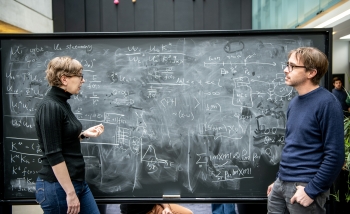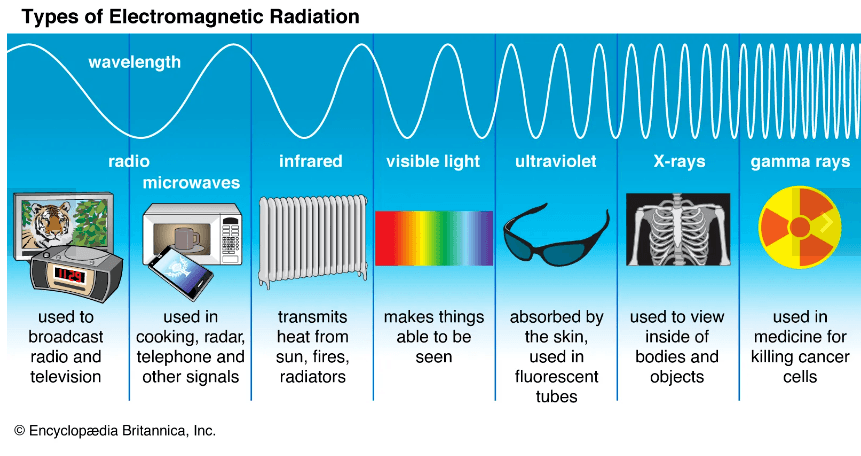It took 70 years to invent radar from James Clerk Maxwell’s 1865 theory of electromagnetism, a classic example of how the road from theoretical physics to application can take a lifetime.
But in a few short years, Barbara Šoda, a postdoctoral researcher at Perimeter Institute, has seen her PhD work on superoscillations turned into a first proof of principle experiment by a team of researchers from Chapman University in California.
It could lead to a kind of “super radar” that would have important applications in military, construction, archeology, mineralogy, and many other domains.
The results, with Šoda as a co-author, were published in early August in Physical Review Letters and highlighted as an Editors’ Suggestion paper. The team demonstrated a radar range resolution more than 100 times better than the long-believed limit.
“We believe this work will open a host of new applications as well as improve existing technologies,” said John Howell, lead author of the paper, in a press release from Chapman University.
Encyclopædia Britannica, types of electromagnetic radiation[/caption]
On the electromagnetic spectrum, radar has long wavelengths compared with, for example, X-rays.
Radar is typically used in applications such as air traffic control or ground-penetrating radar at archeological sites. But in trying to get a good image of the cavity inside a tooth or a good image of the lungs, the long wavelengths of radar do not provide sharp enough resolution. That’s why shorter wavelengths, like X-rays, are used in many medical applications, even though X-rays tend to produce more harmful ionizing radiation.
A few years ago, when Šoda was a PhD student under the supervision of Achim Kempf, a Perimeter Affiliate and University of Waterloo professor, and Lucien Hardy, a Perimeter faculty member, she tackled the problem of how to make radar more broadly applicable.
There has long been this trade-off between wavelength and distance resolution. “Normally, in order to have a good resolution, to have a fine resolution or fine imagery, you need to use short wavelengths,” Kempf explains. “If you use long wavelengths, you need more accuracy. That’s what Barbara’s theoretical work provides: much better accuracy.”
Her method for doing that involves wave oscillations – more specifically, superoscillations.
Most people have seen depictions of sine waves – waveforms that oscillate (move up and down, side to side). Normally, these waves oscillate only as fast as their highest-frequency component. But in the 1990s, Yakir Aharonov (who is affiliated with Chapman University and is a former Distinguished Visiting Research Chair at Perimeter) came up with something quite surprising. Special combinations of these sine waves can produce regions that oscillate faster than any of the constituents of the waves. This was dubbed superoscillation. The idea was further developed by Sandu Popescu of the University of Bristol (and a Distinguished Visiting Research Chair at Perimeter); Sir Michael Berry, also from the University of Bristol (and a former scientific advisor to Perimeter); and their colleagues.
It has long been thought that superoscillations could improve the resolution of radar, but it was not clear how to efficiently generate these superoscillations. That’s what Šoda tackled in her thesis.
Kempf says that Šoda’s PhD thesis, titled “New aspects of quantum interactions: acceleration-induced transparency, Newton’s cradle spectra, superoscillations,” provided “mathematical tricks” for constructing and designing these superoscillations.
“We came up with a way to design the shape of those superoscillations, in this interval where they’re oscillating fast. We can design what they look like, precisely, and that was not possible before,” Šoda says.
At a subsequent conference, Šoda and Kempf discussed the method with one of the Chapman researchers and they took up the challenge of developing new types of signals that improve the function of radar.
According to the press release from Chapman University, the breakthrough idea relies on the superposition of these specially crafted waveforms. The research team used purpose-designed pulses to generate a new kind of superposed pulse.
Normally, the interference of superposed waves would be detrimental, but Andrew Jordan, director of Quantum Studies at Chapman University and one of the co-authors of the paper, said they were able to use these specially designed waveforms to dramatically improve radar range resolution by “orders of magnitude.”
More experiments are on the horizon. “We are now working to demonstrate that it is possible to not only measure the distance between two objects, but many objects or perform detailed characterization of surfaces,” Howell said in the press release.
Šoda grew up in Šibenik, Croatia, and initially dreamed of becoming a professional cellist. But she became fascinated with science. As a teenager, she attended a summer school in Croatia where high school students worked with PhD candidates on research projects and were encouraged to ask deep questions. She continued asking those questions when she arrived at Perimeter to do her master’s through the Perimeter Scholars International program. She has been here ever since, drawn to the freedom to pursue original, and interdisciplinary, ideas.
The improvement in radar resolution has potential applications in all kinds of technologies, from medical tech to mineral prospecting to detection of landmines. “The possibilities are virtually unlimited,” Kempf says.
But he adds that radar is not the only area where Šoda has been making brilliant contributions.
“When Barbara started her PhD, she was looking for topics to work on, and I mentioned a lot of topics. Barbara picked up on several of them, and in each one of them, she has made stunning contributions that led to great papers,” Kempf says. In the preprint (arXiv) archives, she is the co-author of papers on quantum gravity, the emergence of spacetime from fluctuations, and classical-quantum dynamics, among other subjects.
Šoda says her postdoctoral position at Perimeter is designed to be interdisciplinary, which is what she loves. Yet, in the breadth of this wide-ranging research, seeing the ideas from her PhD come to life in experiments is tremendously exciting for a young researcher. “It feels amazing,” says Šoda.
About PI
Perimeter Institute is the world’s largest research hub devoted to theoretical physics. The independent Institute was founded in 1999 to foster breakthroughs in the fundamental understanding of our universe, from the smallest particles to the entire cosmos. Research at Perimeter is motivated by the understanding that fundamental science advances human knowledge and catalyzes innovation, and that today’s theoretical physics is tomorrow’s technology. Located in the Region of Waterloo, the not-for-profit Institute is a unique public-private endeavour, including the Governments of Ontario and Canada, that enables cutting-edge research, trains the next generation of scientific pioneers, and shares the power of physics through award-winning educational outreach and public engagement.
You might be interested in




